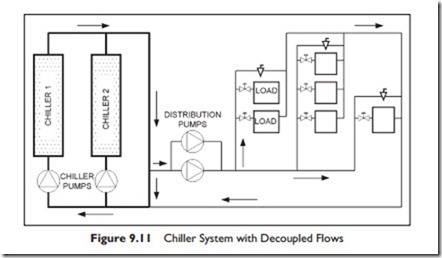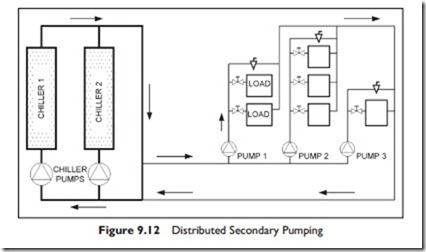Chilled Water
Chilled water typically has a supply temperature of between 42°F and 48°F. Historically, the return temperature was often chosen to be 10°F above the flow temperature. With the higher cost of fuel and the concern over energy usage, it is usually cost effective to design for a higher difference of 15°F or even 20°F. The higher return temperatures require larger coils, and create challenges when high dehumidification is required.
On the other hand, doubling the temperature difference halves the volume flow, and, consequently, reduces the purchase cost of piping and pumps, as well as substantially reducing ongoing pumping power costs.
With a flow temperature in the range 42°F to 48°F, the piping must be insulated to reduce heat gain and avoid condensation. The insulation requires a moisture barrier on the outside to prevent condensation on the pipe.
Chillers, the refrigeration equipment used to produce chilled water, mostly use a direct expansion evaporator. Therefore, the flow must be maintained fairly constant to prevent the possibility of freezing the water. The chiller
requires constant flow but it would be both convenient and economical to have variable flow to the loads. To achieve this, the chiller and loads can be hydraulically “decoupled.” Decoupled, in this context, means that the flows in the chiller circuit do not influence flows in the load circuit. Conversely, changes in the flows in the load circuit do not affect the chiller circuit.
A diagram of two chillers and loads is shown in Figure 9.11. The two chillers are piped in parallel in their own independent pipe loop, shown bold in the Figure. The chiller loop can run even if the distribution pumps are off. Similarly, the distribution loop can run with the chiller pumps off. The short section of shared pipe allows both loops to operate independently of each other, decoupled.
Each chiller has a pump that runs when the chiller runs, producing a chiller- circuit flow of 50% or 100%. The flow in the cooling-loads circuit is dependent on the distribution pumps and whether the valves are fully open or throttling (reducing) the flow. If the chiller flow is higher than the coil circuit, water will flow through the short common section of pipe as the excess chiller water flows round and round the chiller loop. If the chiller flow is less than the coil circuit flow, than some coil return water will flow through the short common section of pipe and mix with the chilled water. When this happens, a flow or temperature sensor will detect it and start another chiller.
The loads in Figures 9.11 and 9.12 are shown as having two way valves which have no flow when they are closed. If all the valves were to close, the pump would be pumping against a closed circuit. To avoid problems occur- ring when this happens, a bypass valve is shown across the end of each branch circuit to allow a minimum flow under all conditions.
The arrangement in Figure 9.11, with distribution pumps serving all loads, requires these pumps to run regardless of the load. On projects where sections of load may be shut down while others are running, a “distributed” pumping arrangement may be more efficient. In Figure 9.12 each secondary loop has its own pump, which is sized to deal with its own loop resistance and the main loop resistance. This system allows pumps 1, 2, and 3 to be run independently, when necessary, to serve their own loads.
The development of economical and sophisticated computer control and affordable variable speed drives, now enables designers to organize piping and
pumping systems that really match need to power, compared to the historical situation where the system used full pump power whenever the system was “on.”

